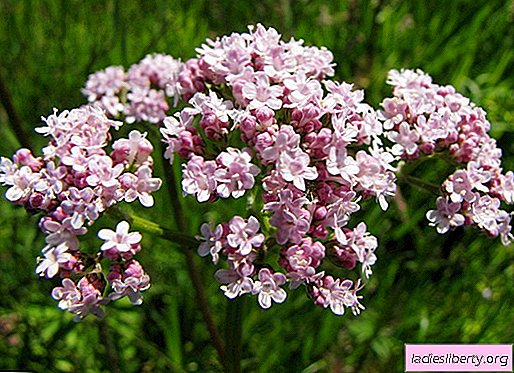
Valerian - General Description
Valerian (more than 15 names - Valerian officinalis, monolith, maun, cat root, etc.) refers to perennial herbaceous plants of the family honeysuckle. On a short thick rhizome (up to 3 cm long) numerous cordy light-brown roots are densely planted, they give a strong specific smell along with a sweet-bitter taste. The stem is straight, ribbed, erect, branched at the top.
In the first year, only rosette leaves grow. Lanceolate, unpaired, dissected, with denticles along the edges of the leaflets appear in the second year. The flower is small, pale pink, fragrant, collected in apical corymbose-paniculate inflorescences. The flowering period of valerian from June to August, this happens only in the second year of life. Ripening occurs from July to September. The fruit is in the form of an oblong ovoid achene with a cirrus tufted. Propagated by seeds.
Valerian - types and places of growth
Around the world, there are about 200 species of valerian. She can well adapt to the conditions of existence, but is considered a water-loving plant. In the middle and southern regions of Russia, valerian is cultivated as a medicinal plant for the needs of pharmacology. In the wild, valerian is distributed almost throughout the CIS, with the exception of Siberia, the desert regions of Central Asia. Most often found in cheese places and on the outskirts of swamps. Boggy meadows, river floodplains, shrubs and thinned forests are favorable for its growth. Wild valerian does not form large thickets.
Valerian - healing properties
For a long time this herb is known mainly as a sedative and sedative. With its help, processes of inhibition in the cerebral cortex are stimulated, coronary circulation improves, and cardiac activity is regulated. The antispasmodic properties of valerian are used to regulate the secretion of the glandular apparatus in the gastrointestinal tract, as well as to suppress the fermentation processes in the intestine. You can make a list of diseases in which this medicinal plant is used: migraine, palpitations, neurosis, hysteria, insomnia, esophageal cramps, flatulence, constipation and others.
Valerian - dosage forms
Valerian is a true champion in the number of drugs manufactured with its use. Healing substances are mainly found in the rhizomes of the flower, which are collected in autumn in the second year of life. Applied in the form of decoctions, tinctures, a thick extract. As part of the collection, it includes sedative tinctures, amphora-valerian and lily of the valley-valerian drops, “Validol”, “Corvalol”, “Valocormid”, “Valedrin”, “Valosedan”, “Cardiovalen”, “Valocordin”, etc. Juice of the grass part plants has a weaker effect, it is used mainly externally in cosmetics and in case of skin damage (when weathered or improper tanning).
Valerian - recipes
The purpose of drugs from valerian should be purely individual.
Decoction. A tablespoon of the roots pour boiling water overnight in a thermos. Take as a sedative in a tablespoon three times a day (no more than 2 months).
In case of nervous disorders in children, valerian baths are recommended. If the gases go off badly for the kids, they prepare a tincture: 1 teaspoon of the crushed roots is poured with a glass of boiling water and infused for 2 hours, filtered. Take 0.5 spoon every 2 hours.
Valerian contraindications
This medicinal plant has practically no contraindications, but it can cause a number of side effects in patients with hypertension in the form of an inverse reaction - excitement and sleep disturbance, heavy dreams. Long-term use of drugs in large quantities can cause an overdose. This is manifested by nausea, an excited state and a headache, sometimes a depressing effect on the digestive organs.
From the history of valerian
Since ancient times, the medicinal properties of this herb have been known. Even the doctors of Ancient Greece considered this plant a means that can control thoughts. For the first time such a version put forward Dioscorides. At that time, Valerian’s ability to “stimulate thought” and strengthen the brain was noticed. Such conclusions were made by Pliny the Elder and Avicenna. In the Middle Ages, she was revered as a medicine with which you can find complacency and calm. The name "forest incense" she found due to its aromatic properties. Peter 1 organized an industrial gathering of this herb and attributed magical properties to it.
Comments











